CARBOHYDRATES
• Carbohydrates: Hydrates of Carbon Cn (H2O)n
• Carbohydrates are polyhydroxy aldehydes such as D-glucose, polyhydroxy ketones such as D-fructose
• The chemical structures of carbohydrates are commonly represented by wedge-and-dash structures or by Fischer projections.
Functions Of Carbohydrate:
1. Carbohydrates are main source of our body. Brain cells and RBC are almost depand only on carbohydrate as a energy source.
Energy source from the carbohydrate is 4 Kcal/gm
2. Storage from of energy ( starch and glycogen).
3. Excess carbohydrate is converted to fat.
4. Glycoprotin and glycolipids are the component of cell membrane and receptors.
5. Structural basis of many organisms:
Cellulose of plants ,exoskeleton of insects , cell wall of microorganisms, mukopolysaccharides as aground substance in higher organism.
Proteins are also main important for our body. It cares various part of our body
Organic chemistry book clayden
Carbohydrates:
The most abundant carbohydrate in nature is D-glucose.
• When animals have more D-glucose than they need for energy, they convert excess D-glucose into a polymer called glycogen.
• When an animal needs energy, glycogen is broken down into individual D-glucose molecules.
• Plants convert excess D-glucose into a polymer known as starch.
• Cellulose—the major structural component of plants—is another polymer of D-glucose.
• Chitin, a carbohydrate similar to cellulose, makes up the exoskeletons of crustaceans, insects, and other arthropods and is also the structural material of fungi.
Classification Of Carbohydrate:
1.Monosaccharides (single sugars)
2. Disaccharides have two sugar subunits linked together
3. Oligosaccharides have three to 10 sugar subunits (oligos is Greek for “few”) linked together
4. Polysaccharides have more than 10 sugar subunits linked together.
Monosaccharides:
Polyhydroxy aldehydes are called aldoses (“ald” is for aldehyde; “ose” is the suffix for a sugar), whereas polyhydroxy ketones are called ketoses.
. Monosaccharides with three carbons are trioses, those with four carbons are tetroses, those with five carbons are pentoses, and those with six and seven carbons are hexoses and heptoses, respectively
For best book preparation for NET EXAM
This book is very much effective for understanding reaction and mechanism



ConversionConversion EmoticonEmoticon